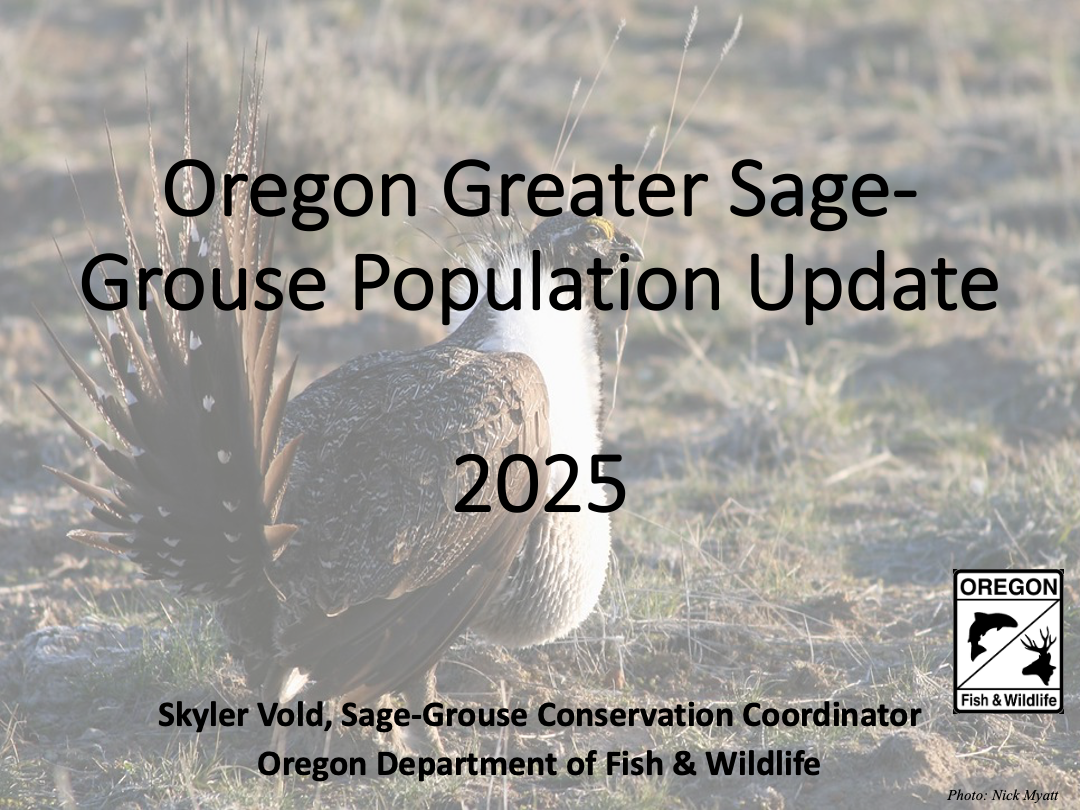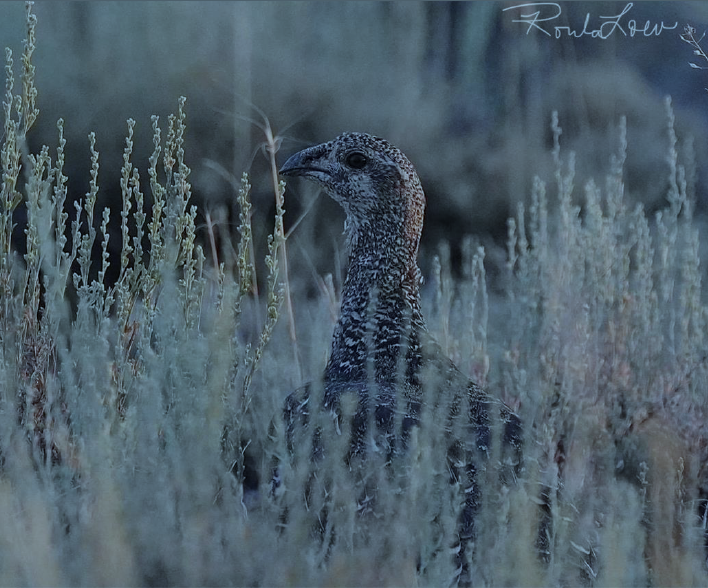Oregon Department of Fish and Wildlife
ODFW Sage-grouse Population Report 2025
This population report is based on lek data collected during the 2025 sage-grouse breeding season (March-April). The surveys utilized 118 observers from ODFW, BLM, and USFWS, as well as many Adopt-a-Lek Program volunteers, to conduct 1,614 ground surveys and 46 aerial (Pueblo and Steens Priority Conservation Areas) lek surveys. These surveys covered 771 (60.9%) of the known lek sites and 482 (56.6%) of the known lek complexes in Oregon.
These results suggest Oregon’s sage-grouse populations are still trending upward in the current population cycle, and the apparent population decline in 2023 was likely a low-biased estimate, driven by lower survey effort in 2023 and abnormally high snowpack in sage-grouse breeding habitat during the 2023 lekking season. Population increases occurred in the Burns, Lakeview, Prineville, and Vale BLM districts at 66.5%, 75.6%, 13.4%, and 69.0%, respectively.
These data are used to inform the BLM’s adaptive management response, build research studies, and plan restoration treatments.
ODFW Sage-grouse Population Report 2024
Roula Leow
The Annual Population Report is conducted during the breeding season (March-April). Staff from ODFW, BLM and USFWS as well as many volunteers conducted 1,550 ground and 63 aerial lek surveys. This covered 696 individual lek sites comprising 424 lek complexes. Surveys were conducted at 55.7% of known lek sites and 50.3% of known lek complexes in the state.
Access to sage-grouse leks was moderate to good in most areas, so lower survey effort this spring was driven by other factors in addition to access and road conditions. Lek survey goals are currently based on monitoring occupied and occupied pending lek complexes, so as more lek complexes transition to ‘unoccupied’ status, apparent lek survey effort based on the proportion of known complexes surveyed will continue to decline.
The estimated spring greater sage-grouse population in Oregon during 2024 was 25,253 individuals , a 63.9% increase from 2023 (2023 estimate = 15,409 individuals. The 2024 statewide population estimate is the highest recorded in Oregon since 2006 and suggests Oregon’s sage-grouse populations are still trending upward in the current population cycle. The population during 2024 was -13.9% below the 2003 baseline population estimate of 29,327 individuals, and the annual average number of males counted per active lek complex has declined by -0.22 males per year since 1980.
These results suggest Oregon’s sage-grouse populations are still trending upward in the current population cycle, and the apparent population decline in 2023 was likely a low-biased estimate, driven by lower survey effort in 2023 and abnormally high snowpack in sage-grouse breeding habitat during the 2023 lekking season. Population increases occurred in the Burns, Lakeview, Prineville, and Vale BLM districts at 66.5%, 75.6%, 13.4%, and 69.0%, respectively.
These data are used to inform the BLM’s adaptive management response, build research studies, and plan restoration treatments.
In March 2022, ODFW initiated its process to update the state’s sage-grouse habitat maps. Core Areas are the lands with the most productive habitat and populations, where we expect to find 90% of the state’s sage-grouse. The updates are based on new population data from the past 12 years and include more than 150 new leks and over 1 million telemetry points from research projects. The updates also include new habitat suitability models with data from ODFW’s Connectivity Assessment. After the initial data synthesis, the maps were reviewed at the district level to include the biologists’ working knowledge of local habitat use. The next phase brought in federal sage-grouse partners from BLM, USFWS, and NRCS for another level of review and updates.
The final phase of this process is the public comment period that opened on July 1st, 2023. During July and August, ODFW sage-grouse specialists attended local sage-grouse working group (LITs) meetings as well as hosted public meetings in Burns, Lakeview, Prineville, Bend, Ontario, and Baker City to discuss the updates with county commissioners, local sage-grouse working groups (LITs), and the public. The draft maps were available for review at ODFW offices and through the SageCon Landscape Planning Tool, which allowed the public to view the updated layers in comparison to the current layers. Public comment was gathered and evaluated through December 13, 2023 and revisions were made based on biological justifications of sage-grouse use of the landscape. The ODFW Commission voted on the revisions at the December 15th, 2023 meeting and unanimously approved the update.
ODFW Sage-grouse Core Area Update
Alex Dohman
Skyler Vold, ODFW Sage-grouse Conservation Coordinator looks for birds in the Brothers PAC.
Written by Rachael Davee, June 23, 2023, Updated December 22, 2023
ODFW Sage-grouse Population Report 2023
The Annual Population Report is conducted during the breeding season (March-April). Staff from ODFW, BLM and USFWS as well as many volunteers conducted 1,099 ground and 97 aerial lek surveys. This covered 588 individual lek sites comprising 367 lek complexes. Surveys were conducted at 48.4% of known lek sites and 44.8% of known lek complexes in the state.
Access to most sage-grouse leks was very difficult or impossible this season due to extended snowpack and poor road conditions decreasing survey efforts from 2022 in terms of the number of surveys conducted (-52.3%), number of leks surveyed (-34.9%), and number of complexes surveyed (-44.1%). This constitutes the lowest lek survey effort in Oregon since 2014 for the proportion of known complexes surveyed and the proportion of known leks surveyed.
Results from these surveys indicate the sage-grouse spring breeding population in Oregon decreased by -11.4% between 2022 and 2023, to 15,503 estimated individuals (95% CI: 13,886–17,121 individuals). These results indicate the first year of statewide population decline following three consecutive years of a statewide increase, 2020–22. However, these results must be interpreted with caution due to the abnormal snowpack in sage-grouse breeding habitat during the 2023 lekking season, and the low survey effort this spring compared to the previous 8 years.
Roula Leow
The 2023 population estimate is the third lowest estimated sage-grouse population in Oregon during the analysis period of 1980–2023. Population increases occurred in the Burns and Lakeview BLM Districts, at 1.1% and 12.3%, respectively. Population declines occurred in the Prineville and Vale BLM Districts, at -9.7% and -27.8%, respectively. The estimated sage-grouse population in the Baker BLM Resource Area apparently decreased by -14.0%, however, due to issues with population analysis methodology in this area, our confidence in trend estimates in this area is lower than in other areas of the state. Observed population increases or decreases in the Baker Resource Area are likely accurate but the magnitude of annual population trends is likely inflated.
These data are used to inform the BLM’s adaptive management response, build research studies, and plan restoration treatments.
Skyler Vold
Landon Hardt









